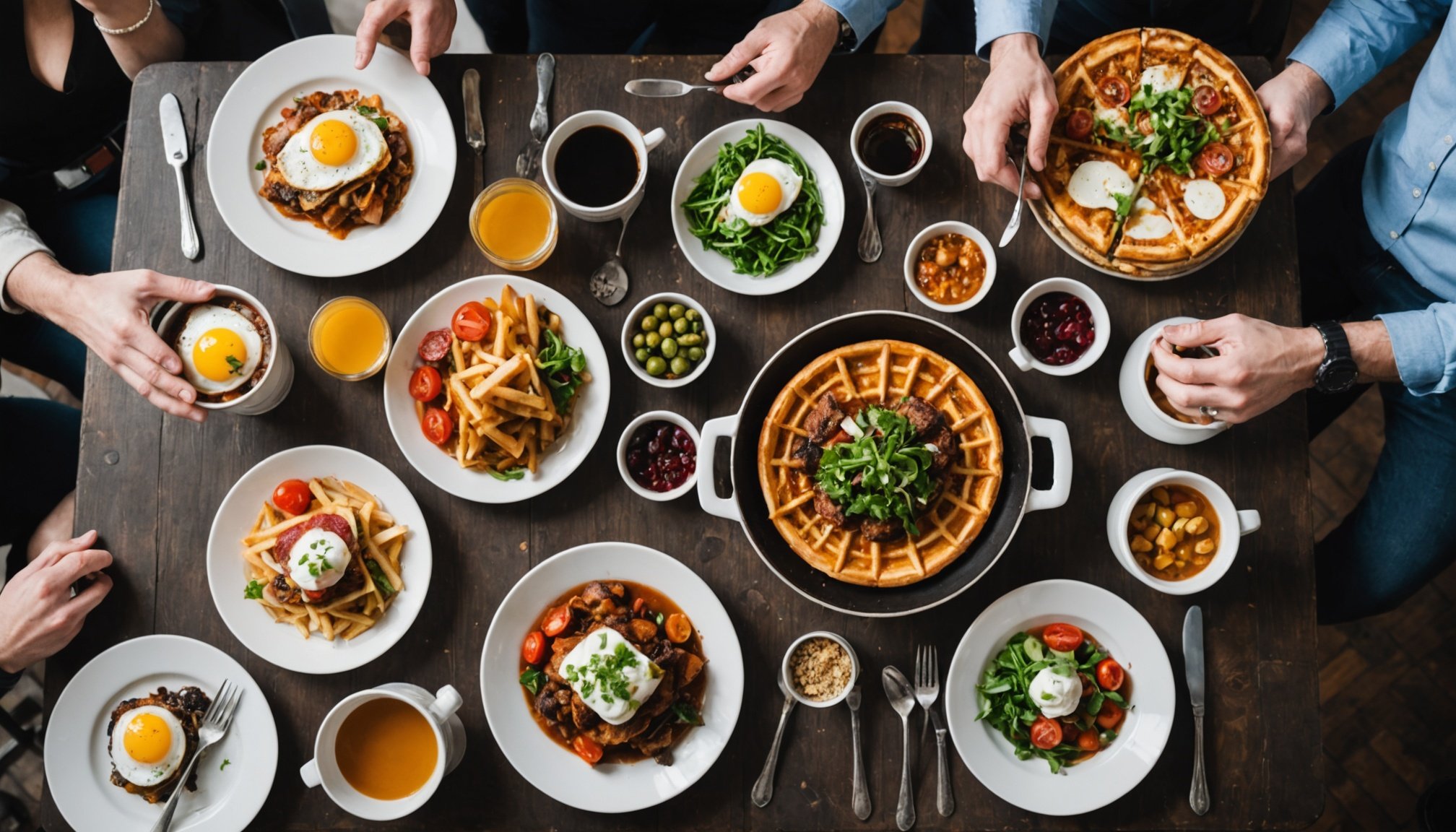Ultimate Guide to Developing a Comprehensive Social Media Strategy for UK Restaurants: Your Step-by-Step Blueprint
In the bustling world of UK restaurants, having a robust social media strategy is no longer a luxury, but a necessity. It’s your key to connecting with your audience, boosting brand awareness, and driving business growth. Here’s a detailed, step-by-step guide to help you create and implement a winning social media strategy for your restaurant.
Define Your Goals
Before diving into the world of social media, it’s crucial to define what you want to achieve. Your goals should be SMART – Specific, Measurable, Achievable, Relevant, and Timely. Here are some examples of goals that could work for your restaurant:
In the same genre : Crafting an invincible cybersecurity blueprint: key tactics for e-commerce platforms in the uk
- Increase brand awareness: Aim to increase your social media reach by 10% in the first quarter of 2024.
- Boost customer engagement: Target a 20% increase in likes, comments, and shares on your posts within the next six months.
- Drive sales: Increase the number of customers who visit your restaurant after seeing your social media posts by 15% in the next year.
Having clear goals will help you stay focused and measure the success of your social media efforts[5].
Understand Your Target Audience
Knowing your audience is vital for any successful social media strategy. Here are some steps to help you understand your target audience better:
Have you seen this : Building an effective crisis communication plan for uk enterprises: a comprehensive step-by-step blueprint
Identify Demographics
- Age: Are your customers primarily young professionals, families, or retirees?
- Location: Are they local residents or tourists?
- Interests: What do they like to do in their free time?
Analyze Customer Behavior
- What times of the day are they most active on social media?
- Which platforms do they prefer? (e.g., Facebook, Instagram, TikTok)
- What type of content do they engage with most? (e.g., food photos, behind-the-scenes videos, customer testimonials)
Create Buyer Personas
Develop detailed personas based on your research. For example:
| Persona | Age | Location | Interests | Preferred Platforms |
|---|---|---|---|---|
| Young Professional | 25-35 | Urban | Foodie culture, travel | Instagram, TikTok |
| Family | 30-50 | Suburban | Family activities, health | Facebook, Pinterest |
| Retiree | 60+ | Rural | Local events, gardening | Facebook, Twitter |
Understanding your audience will help you tailor your content and engagement strategies to their needs and preferences[4].
Choose the Right Social Media Platforms
Not all social media platforms are created equal, and each has its unique strengths and user demographics. Here’s a brief overview of the most popular platforms for restaurant marketing:
- Best for: Customer service, local advertising, and community building.
- Example: Use Facebook to share updates about new menu items, special promotions, and events. Encourage customers to leave reviews and engage with your posts[3].
- Best for: Visual storytelling, influencer partnerships, and user-generated content.
- Example: Share high-quality photos of your dishes, behind-the-scenes kitchen shots, and customer photos using a branded hashtag. Collaborate with local influencers to showcase your restaurant[1].
TikTok
- Best for: Short-form videos, trending challenges, and younger audiences.
- Example: Create short, engaging videos showcasing your chefs preparing dishes, or participate in popular food-related challenges to increase your visibility[3].
- Best for: Real-time engagement, customer service, and news updates.
- Example: Use Twitter to respond quickly to customer queries, share news about your restaurant, and engage in relevant conversations using hashtags[2].
Create Engaging Content
Your content is the heart of your social media strategy. Here are some tips to help you create engaging content:
Visual Content
- Photos: Share high-quality photos of your dishes, restaurant interior, and exterior.
- Videos: Create short videos showcasing your chefs, kitchen tours, or customer testimonials.
- Stories: Use Instagram and Facebook Stories to share behind-the-scenes content, sneak peeks, and exclusive offers.
User-Generated Content
- Encourage customers to share photos or videos of their dining experience using a branded hashtag.
- Repost or feature user-generated content on your social media profiles to build trust and engagement[1].
Authentic and Personal Content
- Share the stories of your chefs, staff, and the history of your restaurant.
- Be transparent and genuine in your communications to build trust with your audience[1].
Example Content Calendar
Here’s a sample content calendar to help you get started:
| Day | Platform | Content Type | Description |
|---|---|---|---|
| Monday | Photo | New menu item launch | |
| Tuesday | Video | Behind-the-scenes kitchen tour | |
| Wednesday | TikTok | Short Video | Chef preparing a dish |
| Thursday | Tweet | Special promotion announcement | |
| Friday | Story | Sneak peek of weekend specials | |
| Saturday | User-Generated Content | Feature customer photo with branded hashtag | |
| Sunday | Post | Weekly menu highlights |
Engage with Your Audience
Engagement is a two-way street on social media. Here are some tips to help you engage effectively with your audience:
Social Listening
- Set up streams to track mentions of your brand, products, and industry.
- Respond promptly to both positive and negative feedback to show that you value customer opinions[1].
Direct Messages and Comments
- Use direct messages (DMs) to handle customer inquiries and complaints privately.
- Respond to comments and @-mentions within 24 hours to maintain transparency and build trust[3].
Influencer Partnerships
- Collaborate with local influencers or social media personalities to reach a wider audience.
- Choose influencers who align with your brand values and target audience[2].
Use Targeted Advertising
Social media advertising can be highly effective if done correctly. Here are some tips for using targeted ads:
Define Your Target Audience
- Use demographic data, interests, behaviors, and location to target your ads.
- Create lookalike audiences based on your existing customer base to reach new potential customers[1].
Choose the Right Ad Formats
- Use video ads, carousel ads, and story ads to engage your audience visually.
- Utilize promotional offers and exclusive deals to drive immediate action[3].
Monitor and Adjust
- Use social media analytics to track the performance of your ads.
- Adjust your targeting, ad creative, and budget based on the data to optimize your ad campaigns[1].
Analyze and Adjust Your Strategy
Analytics are crucial for understanding the effectiveness of your social media strategy. Here’s how you can use analytics to your advantage:
Track Key Metrics
- Monitor engagement rates, reach, clicks, and conversions.
- Use tools like Hootsuite Insights or Sprout Social to get detailed reports on your performance[1].
Adjust Your Content and Ads
- Based on your analytics, adjust the type of content you post and the targeting of your ads.
- Experiment with different formats and strategies to see what works best for your audience[5].
Example Analytics Report
Here’s a sample analytics report to help you understand how to track your performance:
| Metric | Current Performance | Goal | Action Plan |
|---|---|---|---|
| Engagement Rate | 2% | 5% | Increase engagement by posting more interactive content (polls, quizzes). |
| Reach | 10,000 | 15,000 | Expand reach by running targeted ads and collaborating with influencers. |
| Clicks | 500 | 1,000 | Improve click-through rates by using more compelling ad creatives. |
| Conversions | 50 | 100 | Increase conversions by offering exclusive deals and promotions. |
Practical Insights and Actionable Advice
Here are some practical tips to help you implement your social media strategy effectively:
Be Consistent
- Post content regularly to keep your audience engaged.
- Use a content calendar to plan and schedule your posts in advance[5].
Be Authentic
- Share genuine stories and behind-the-scenes content to build trust.
- Engage with your audience in a transparent and honest manner[1].
Use Holiday and Seasonal Trends
- Leverage holiday shopping trends to create special promotions and content.
- Use seasonal themes to make your content more relevant and engaging[3].
Quotes and Examples
Here are some quotes and examples to inspire you:
- “Social media is no longer optional. It’s an essential way to reach your customers, gain valuable insights, and grow your brand.”[1]
- Nike’s #MakeItCount Campaign: Nike saw an 18% increase in profit after launching a viral social media campaign that encouraged users to share their experiences using a branded hashtag[2].
Developing a comprehensive social media strategy for your UK restaurant is a multifaceted process that requires careful planning, execution, and continuous improvement. By defining clear goals, understanding your target audience, creating engaging content, engaging with your audience, using targeted advertising, and analyzing your performance, you can significantly enhance your restaurant’s online presence and drive business growth.
Remember, social media is a dynamic field, and what works today may not work tomorrow. Stay flexible, keep learning, and always be ready to adapt your strategy to the changing needs of your audience and the evolving social media landscape.
With the right approach, your social media strategy can become a powerful tool to help your restaurant thrive in the competitive UK dining scene. So, take the first step today, and watch your business flourish in the digital age.











